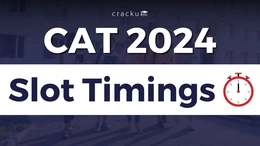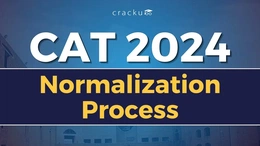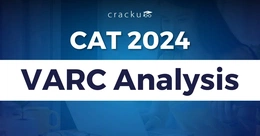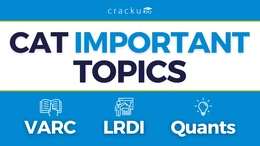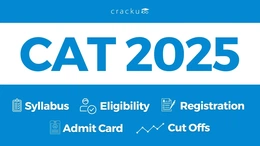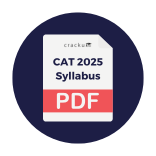CAT Exam Analysis 2024
CAT Exam Analysis: As the day of the examination came, CAT exam analysis 2024 have been provided here. For each of the three slots, Cracku has offered thorough CAT paper analysis so that candidates may evaluate their performance. The CAT 2024 analysis are into great detail about the section CAT cut off, test structure, changes (if any), difficulty level of the sections, and topic weighting. On November 24, 2024, you can view the analysis of the CAT exam. Here in this article, we have provided the CAT last 5 years paper analysis for the reference of the candidates
Sections | Total Questions | Difficulty Level | No of MCQ Questions | No of TITA Questions |
| Slot 1 | 68 | Easy-Moderate | 48 | 20 |
| Slot 2 | 68 | Moderate | 50-52 | 16-18 |
| Slot 3 | 68 | Easy-Moderate | 50-52 | 16-18 |
CAT Slot-wise Exam Analysis 2024
As of now, we have mentioned here the tables and pattern what we will be discussing Once the exam is over, we will be updating the overall details of the CAT paper analysis. Here we will discuss the complete slot-wise CAT exam analysis for CAT 2024, which will be for all 3 slots and their section-wise breakdown: Verbal Ability & Reading Comprehension (VARC), Data Interpretation & Logical Reasoning (DILR), and Quantitative Ability (QA).
Here we will analyse the types of questions, CAT difficulty level, and topic-wise distribution for each slot and their section, helping candidates identify important areas to focus on.
CAT Exam Analysis 2024: Slot 1
CAT 2024 Slot 1 Analysis provides an overview of the first exam session, covering section difficulty, the number of questions, question patterns, and changes from previous years.
Sections | Total Questions | Difficulty Level | No of MCQ Questions | No of TITA Questions | Good Attempts |
| VARC | 24 | Moderate | 2 | 22 | 17-18 |
| DILR | 22 | Easy - Moderate | 10 | 12 | 12-13 |
| QA | 22 | Moderate | 8 | 14 | 13-14 |
TOTAL | 68 | Moderate | 20 | 48 | 45-47 |
CAT Exam Analysis 2024: Slot 2
Here we will discuss the complete details on CAT 2024 Slot 2 exam analysis for all 3 sections, which include total questions, difficulty level, or any other important changes.
Sections | Total Questions | Difficulty Level | No of MCQ Questions | No of TITA Questions | Good Attempt |
| VARC | 24 | Easy-Moderate | 2 | 22 | 17-18 |
| DILR | 22 | Moderate | 6-8 | 14-16 | 12-13 |
| QA | 22 | Moderate | 6-8 | 14-16 | 13-14 |
TOTAL | 68 | Moderate | 16-18 | 50-52 | 45-47 |
CAT Exam Analysis 2024: Slot 3
Below table we have discussed complete details on CAT slot 3 exam analysis such as total questions, difficulty level, or any other important changes.
Sections | Total Questions | Difficulty Level | No. of TITA Questions | No. of MCQ Questions | Good Attempts |
| VARC | 24 | Moderate - Difficult | 2 | 22 | 17-18 |
| DILR | 22 | Moderate | 6-8 | 14-16 | 12-13 |
| QA | 22 | Moderate | 6 | 16 | 13-14 |
TOTAL | 68 | Moderate | 14-16 | 48-52 | 45-47 |
CAT Previous Year Paper Analysis
We have offered a thorough analysis of the trends in the CAT exam analysis for the last 5 years, covering significant factors such as sectional patterns, topic-wise weightage, difficulty level, and question structure.
With a focus on the most relevant subjects from previous years, this CAT exam analysis will help candidates in better understand the dynamic nature of the CAT exam and helping them prepare. Aspirants can learn which areas and topics have received greater attention by examining these trends, and they can then adjust their preparation for the next CAT exams.
Also Read, CAT Response Sheet 2024, Release Date, Download Link
CAT Paper Analysis 2023
Overall, the format and level of difficulty of the paper for every slot were same to those of CAT 2022 except for VARC, In VARC number of questions were same but there were 2 para-insertion question which were new in VARC section . The CAT slot 3 Quant section in 2023 was more difficult than slots 1 and 2. The Quantitative Aptitude portion was more difficult in all three positions compared to VARC and DILR. The CAT question paper was more challenging at IIM Lucknow than it was at other IIM Colleges.
Hence, below we have provided the CAT 2023 Paper Analysis for all the three slots -
CAT 2023 Paper Analysis Slot 1
Sections | Difficulty Level | No of Questions | Good Attempt |
VARC | Moderate | 24 | 16-18 |
DILR | Moderate to difficult | 20 | 10-12 |
Quants | Difficult | 22 | 12-13 |
CAT 2023 Paper Analysis Slot 2
Sections | Difficulty Level | No of Questions | Good Attempt |
VARC | Moderate | 24 | 17-19 |
DILR | Difficult | 20 | 10-12 |
Quants | Difficult | 22 | 10-12 |
CAT 2023 Paper Analysis Slot 3
Sections | Difficulty Level | No of Questions | Good Attempt |
VARC | Easy-Moderate | 24 | 16-18 |
DILR | Moderate | 20 | 10-11 |
Quants | Difficult | 22 | 12-14 |
CAT Paper Analysis 2022
The CAT 2022 Question Paper's format was same to the CAT 2021 and did not have changes in any way. There were 66 questions altogether from the three exam sections, with a moderate overall difficulty level. In DILR section there were 4 sets of 5 questions each, whereas in CAT 2022 there were 2 sets of 6 questions and 2 sets of 4 questions each.
Hence, below we have provided the CAT 2022 Paper Analysis for all the three slots -
CAT 2022 Paper Analysis Slot 1
Sections | Difficulty Level | No of Questions | Good Attempt |
VARC | Moderate | 24 | 16-18 |
DILR | Difficult | 20 | 10-12 |
Quants | Moderate | 22 | 14-16 |
CAT 2022 Paper Analysis Slot 2
Sections | Difficulty Level | No of Questions | Good Attempt |
VARC | Moderate to difficult | 24 | 15-17 |
DILR | Moderate | 20 | 12-14 |
Quants | Difficult | 22 | 10-12 |
CAT 2022 Paper Analysis Slot 3
Sections | Difficulty Level | No of Questions | Good Attempt |
VARC | Moderate to difficult | 24 | 15-17 |
DILR | Moderate | 20 | 10-11 |
Quants | Difficult | 22 | 12-14 |
CAT Paper Analysis 2021
The entire set of questions was of moderate difficulty. The cat exam analysis of 2021 indicates that the reading comprehension passages were challenging to pass. Candidates had a difficult time deciding which of the four passages to take on because just one of the passages was simple. There were four portions in the DILR segment, and selecting only one was challenging because only one set was simple.
In reality, during the previous few years, the set on bar graphs was the simplest across the CAT DILR. However, the portion on quantitative aptitude with its simple and easy-to-understand questions was surprising.
Hence, below we have provided the CAT 2021 Paper Analysis for all the three slots -
CAT 2021 Paper Analysis Slot 1
Sections | Difficulty Level | No of Questions | Good Attempt |
VARC | Moderate to difficult | 24 | 15-16 |
DILR | Difficult | 20 | 10-12 |
Quants | Difficult | 22 | 12-14 |
CAT 2021 Paper Analysis Slot 2
Sections | Difficulty Level | No of Questions | Good Attempt |
VARC | Moderate | 24 | 16-18 |
DILR | Moderate to difficult | 20 | 10-12 |
Quants | Difficult | 22 | 10-12 |
CAT 2021 Paper Analysis Slot 3
Sections | Difficulty Level | No of Questions | Good Attempt |
VARC | Moderate | 24 | 15-17 |
DILR | Difficult | 20 | 10-11 |
Quants | Moderate | 22 | 13-15 |
Also read, CAT Exam Day Guidelines 2024, Dress Code, Security Check
CAT Paper Analysis 2020
IIM Indore administered the CAT 2020, with a 120-minute time limit and a total of 76 questions on the exam. Overall, the paper was moderate to difficult for all the candidates. It was a sudden shift from 3 hour format to 2 hour format. Not only that earlier, CAT used to be in 2 slots, i.e in morning and evening, but from 2020 is one more shift was introduced, i.e., overall, 3 shifts.
Hence, below we have provided the CAT 2020 Paper Analysis for all the three slots -
CAT 2020 Paper Analysis Slot 1
Sections | Difficulty Level | No of Questions | Good Attempt |
VARC | Moderate | 26 | 17-19 |
DILR | Difficult | 24 | 10-12 |
Quants | Moderate to Difficult | 26 | 12-14 |
CAT 2020 Paper Analysis Slot 2
Sections | Difficulty Level | No of Questions | Good Attempt |
VARC | Moderate to Difficult | 26 | 15-17 |
DILR | Moderate | 24 | 11-13 |
Quants | Difficult | 26 | 10-12 |
CAT 2020 Paper Analysis Slot 3
Sections | Difficulty Level | No of Questions | Good Attempt |
VARC | Moderate | 26 | 16-18 |
DILR | Difficult | 24 | 12-14 |
Quants | Moderate | 26 | 13-15 |
CAT Paper Analysis 2019
The CAT 2019 paper was moderate to difficult, with the quantitative aptitude section being the toughest. Verbal ability was manageable, while data interpretation and logical reasoning posed moderate challenges. It was held in 3-hour format. It was held in 2 shifts.
Hence, Below we have provided the CAT 2019 Paper Analysis for all the three slots -
CAT 2019 Paper Analysis Slot 1
Sections | Difficulty Level | No of Questions | Good Attempt |
VARC | Moderate to Difficult | 34 | 22-24 |
DILR | Difficult | 32 | 16-17 |
Quants | Moderate to Difficult | 34 | 18-20 |
CAT 2019 Paper Analysis Slot 2
Sections | Difficulty Level | No of Questions | Good Attempt |
VARC | Moderate | 34 | 23-25 |
DILR | Difficult | 32 | 16-17 |
Quants | Moderate to Difficult | 34 | 21-22 |
Important Topics Based on last 5-year CAT exam analysis
According to the last 5-year CAT exam analysis, certain CAT important topics have been key to successful preparation. In quantitative aptitude, areas like arithmetic, algebra, and geometry are common. For VARC, reading comprehension often covers subjects like philosophy and history, while DILR tends to include puzzles and data interpretation. If you're looking for free CAT preparation resources, you can check the below-given table, where we have mentioned some of the important topics according to the CAT Exam Syllabus.
| VARC Section | DILR Section | Quantitative Aptitude Section |
| Philosophy | Arrangements | Arithmetic |
| Psychology | Puzzles | Algebra |
| History | Data Interpretation | Geometry |
| Science and Technology | Games and Tournaments | Number system |
Conclusion
In conclusion, the CAT exam analysis 2024 highlights varying difficulty levels each year, with specific sections posing more challenges. Candidates must focus on improving time management, accuracy, and sectional performance.
Regular practice, mock tests, and understanding exam patterns are crucial for success. A strategic approach tailored to individual strengths and weaknesses can significantly improve CAT performance. you can also check Cracku's CAT online coaching for further CAT preparation.




